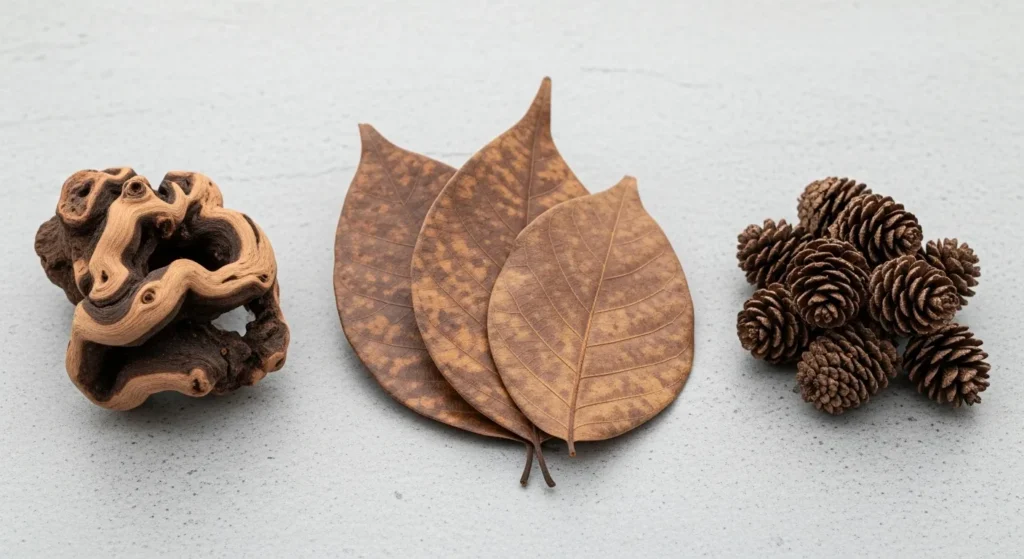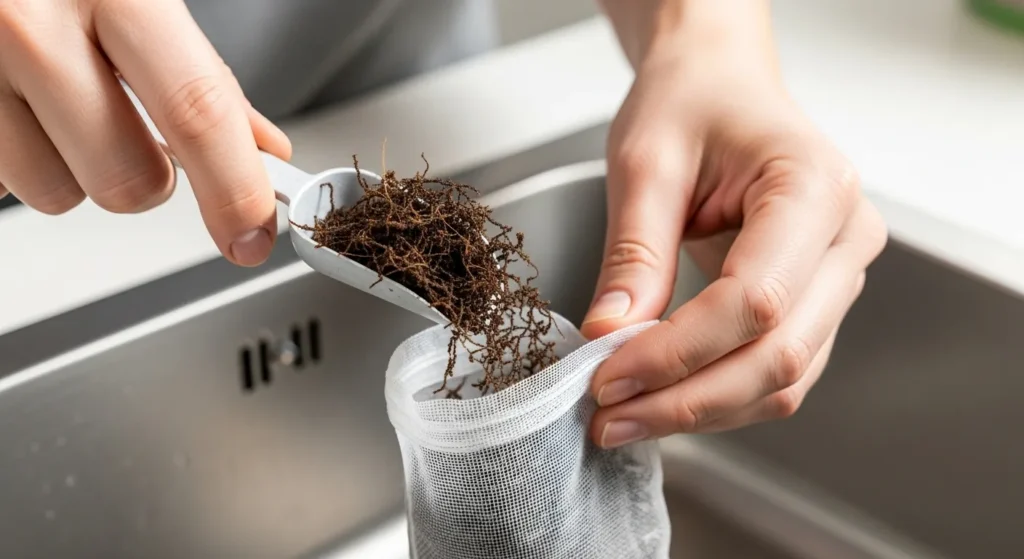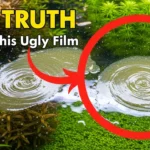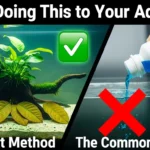If you’ve started to research the water in your aquarium, you’ve probably run into two little letters that cause a whole lot of stress: pH.
You read online forums or watch videos, and suddenly you’re seeing charts, numbers, and urgent advice about needing a “perfect” pH level for your fish. You might see bottles of “pH Down” at the pet store and feel a sense of panic, thinking it’s another complicated chemical you have to master.
I’m here to tell you to take a deep breath. After years of setting up and maintaining beautiful, stable aquariums, I can tell you that the frantic chase for a specific pH number is one of the biggest and most dangerous traps for beginners.
Today, we’re going to explore how to lower ph in your aquarium the right way—the natural, safe, and stable way. We’re going to skip the risky chemical shortcuts and instead learn how to work with nature to create the soft, gentle water that many tropical fish and plants absolutely love. This isn’t about chemistry experiments; it’s about creating a healthy, thriving ecosystem.
Why Chasing a “Perfect” pH is a Beginner’s Trap
Let’s get this out of the way first: Stability is far more important than a specific pH number.
Fish are incredibly adaptable creatures. The vast majority of popular aquarium fish sold today are raised in commercial fish farms in water that is often very different from their native habitat. A Neon Tetra can be perfectly happy and healthy in water with a pH of 7.4, just as a Guppy can be in water with a pH of 6.8.
What fish cannot handle are rapid, constant changes. Using chemical pH adjusters often leads to a dangerous rollercoaster effect. You add the chemical, the pH plummets. A day later, it creeps back up. You add more chemical, it plummets again. This constant fluctuation is incredibly stressful for your fish and is far more likely to cause health problems than a stable, slightly “imperfect” pH.
Our goal is not to hit a magic number. Our goal is to create a naturally stable environment. If we can gently and permanently lower the pH in the process, that’s a fantastic bonus.
Understanding KH: The Hidden Factor That Controls Your pH
Before you can effectively change your pH, you have to understand what’s holding it in place. Think of your aquarium water as having an invisible “pH anchor.” This anchor is called Carbonate Hardness, or KH.
In simple terms, KH is a measure of dissolved carbonates and bicarbonates in your water. These minerals act as a buffer, resisting changes in pH.
- High KH: If your tap water has a high KH, it has a very strong pH anchor. You can add things to lower the pH, but the KH will constantly work to push it back up. It’s like trying to hold a beach ball underwater; the moment you let go, it pops right back up to the surface.
- Low KH: If your water has a low KH, its pH anchor is weak. The pH can be changed much more easily and will remain at the new level.
This is why dumping a bottle of “pH Down” into high-KH water is so ineffective and dangerous. The chemical temporarily overcomes the buffer, causing a rapid pH crash, but the KH immediately starts working to raise it again, creating that stressful rollercoaster.
To lower pH naturally and permanently, our strategy is simple: we need to gently and slowly reduce the KH. The methods we’re about to discuss don’t just target the pH; they target the KH anchor itself.
Also Read: The 12 Best Plants for a Low-Tech Aquarium (2025 Guide)
Method 1: Using Natural Botanicals (The Aquascaper’s Secret)

This is my favorite method. It’s beautiful, natural, and replicates the true environment of many of our favorite fish. Botanicals are simply dried leaves, seed pods, and wood that, when added to your aquarium, slowly release beneficial compounds.
The magic ingredient here is tannins. Tannins are natural organic compounds that give rivers like the Amazon their characteristic tea-colored stain. When you add botanicals to your tank, they leach these tannins into the water.
Here’s the simple science: The tannins release mild acids into the water. These acids react with and use up the carbonate buffers (the KH). As the KH is gradually consumed, the pH anchor weakens, allowing the pH to naturally and safely drift downwards and remain there.
Popular Botanicals for Your Low-Tech Tank:
- Driftwood: This is the cornerstone of a natural pH-lowering setup. Pieces like Malaysian or Mopani driftwood are rich in tannins. Not only do they lower pH, but they also provide a beautiful, natural centerpiece for your aquascape and a surface for plants and beneficial bacteria to grow on. You’ll need to boil or soak new driftwood before adding it to your tank to make it sink and to release some of the initial heavy tannins.
- Indian Almond Leaves (Catappa Leaves): These are a secret weapon for fish breeders and shrimp keepers. They release a significant amount of tannins and have well-documented antibacterial and antifungal properties, promoting overall fish health. You simply drop a leaf or two into your tank, and as it breaks down over a few weeks, it works its magic.
- Alder Cones: These small, pinecone-like pods are tannin powerhouses. Because of their small size, you can add just a few to gently influence your water. They are perfect for smaller tanks or for making minor adjustments.
| Botanical | pH Lowering Effect | Longevity | Visual Impact |
|---|---|---|---|
| Driftwood | Gentle & Slow | Very Long (Years) | Major Aquascape Element |
| Catappa Leaves | Moderate & Steady | Short (Weeks) | Natural Leaf Litter Look |
| Alder Cones | Strong & Fast | Medium (Months) | Small, Subtle Addition |
Method 2: Incorporating Peat Moss into Your Filter

This is a classic, old-school method that is incredibly effective, especially if you have high KH tap water.
Peat moss is a type of decomposed plant matter that is rich in humic acids, which work in the same way as tannins. They gradually bind with the carbonates in your water, softening it and lowering the pH.
The best way to use peat is to place it in your filter. You should never use garden-store peat, which may contain pesticides. Only use aquarium-grade peat moss.
How to Use Peat Moss Safely:
- Purchase aquarium-grade peat moss.
- Place a small amount of the peat into a fine mesh filter bag.
- Rinse the bag well to remove any dust.
- Place the bag in one of the compartments of your hang-on-back or canister filter so that water is forced to flow through it.
- Start with a small amount and test your water every couple of days. Peat can be very effective, so it’s important to make changes slowly.
The peat will need to be replaced every few months as its acids are used up. This is a fantastic, budget-friendly option for achieving that soft, acidic water that fish like tetras, rasboras, and Betta fish love.
Method 3: Choosing the Right Substrate
Your substrate—the foundation of your tank—can also have a major impact on your pH. Many common gravels and sands sold for aquariums contain crushed corals, shells, or certain types of rock that will slowly leach minerals into your water, actively raising your KH and pH.
If your goal is to lower or maintain a low pH, you must choose an inert substrate or an active substrate that lowers pH.
- Inert Substrates: These will not affect your water chemistry. Things like pool filter sand, quartz-based gravels, or commercial clay substrates like Seachem Flourite are excellent choices. They provide a stable foundation without working against your efforts.
- Active Substrates (Aquasoils): Many popular commercial substrates, like Fluval Stratum or Tropica Aquarium Soil, are designed to be “active.” They are made of materials that will naturally pull KH from the water and lower the pH, creating ideal conditions for plant growth. While they are more expensive, they can be a powerful tool in your quest for soft water. For a full breakdown, you can read our Ultimate Guide to Substrate for a Low-Tech Planted Tank.
Why You Should Avoid “pH Down” Chemicals
Now we come to those little bottles on the pet store shelf. They seem so easy. Just a few drops, and your pH problem is solved, right?
Wrong.
As we discussed, these products are typically strong acids that do not address the root cause of high pH—your water’s KH. They cause a sudden, sharp drop in pH that is incredibly stressful for your fish. Because the KH buffer is still present, it will immediately start working to raise the pH back up, and you’ll find yourself stuck in a vicious cycle of chemical additions and pH swings.
There is almost no situation in a beginner’s low-tech aquarium where these products are the right answer. The natural, gradual methods of using botanicals, peat, and the right substrate are safer, more stable, and create a genuinely healthier ecosystem for your tank’s inhabitants.
Conclusion: Embrace Stability, Not Numbers
Learning how to lower ph in your aquarium is not about becoming a chemist. It’s about becoming a better aquatic gardener. It’s about understanding that your aquarium is a tiny ecosystem, and the best way to manage it is by using gentle, natural inputs that create long-term stability.
Forget about chasing a perfect number on a test strip. Instead, focus on creating a beautiful, natural environment with driftwood, leaves, and the right foundation. By doing so, you will not only create the soft, acidic water that many species thrive in, but you will also build a more stable, more resilient, and ultimately more enjoyable aquarium. And that is a far greater achievement than any number on a chart.

Daniel Ravera is the founder of AquaInitium, where he shares insights gained from over a decade of hands-on aquascaping. His expertise lies in the low-tech, ecosystem-first method—a philosophy he adopted after experiencing the common frustrations of algae and instability himself. As an authority in the beginner aquascaping niche, Daniel provides clear, trustworthy advice to help you build a beautiful, stable aquarium and avoid the costly mistakes he learned the hard way.











1 thought on “How to Lower Aquarium pH Naturally (A Safe, Beginner’s Guide)”